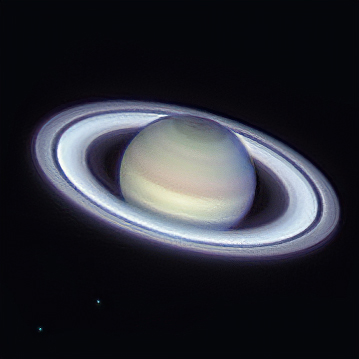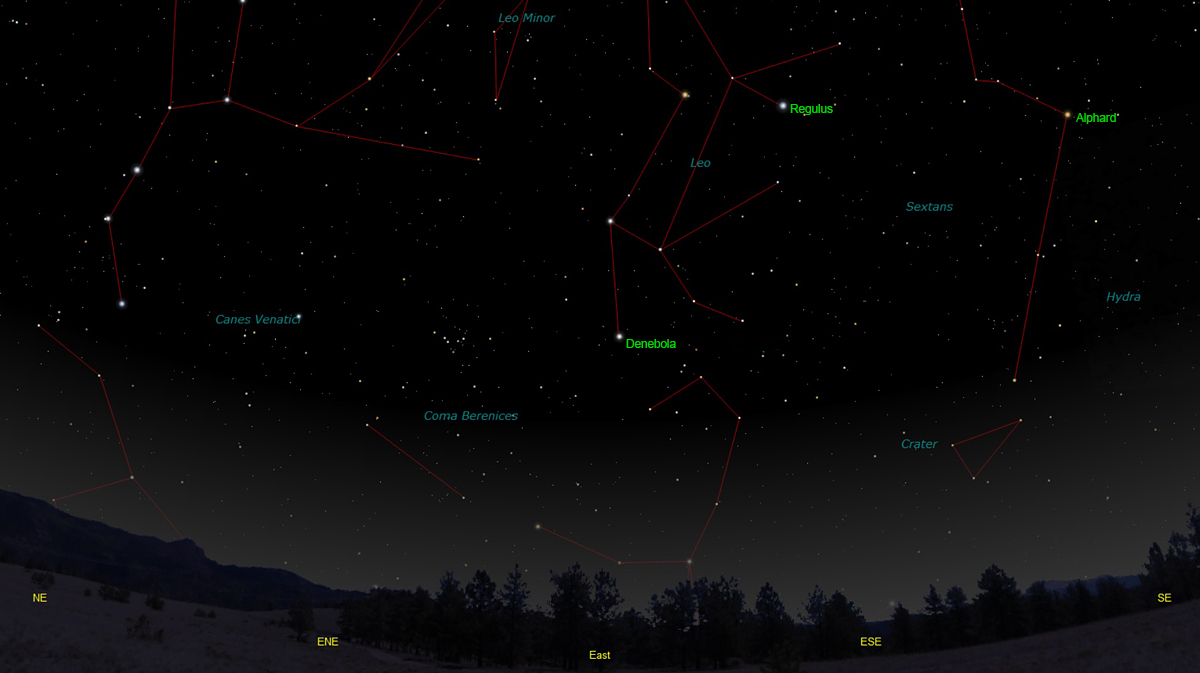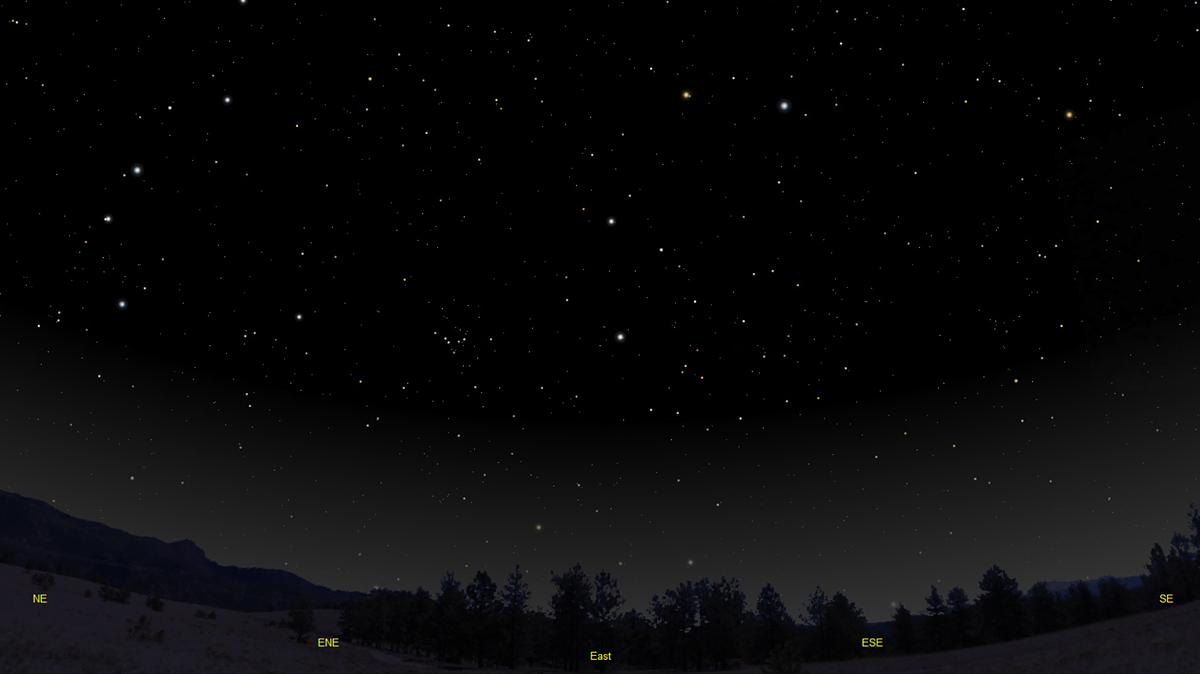The purpose of this feature is to give scout leaders, educators and naturalists an idea of some of the natural events coming up each month. We will try to cover a variety of natural events ranging from sky events to calling periods of amphibians, bird and mammal watching tips, prominent wildflowers and anything else that comes to mind. We will also note prominent constellations appearing over the eastern horizon at mid-evening each month for our area for those who would like to learn the constellations. If you have suggestions for other types of natural information you would like to see added to this calendar, let us know! Note: You can click on the hyperlinks to learn more about some of the featured items. To return to the Calendar, hit the "back" button on your browser, NOT the "back" button on the web page. All charts are available in a "printer friendly" mode, with black stars on a white background. Left clicking on each chart will take you to a printable black and white image. Though we link book references to nationwide sources, we encourage you to support your local book store whenever possible.
Notes From January 2021 After imaging Mars, Jupiter and Saturn this fall I was ready to return to the deep sky. On January 5th I converted my observatory telescope back to its galaxy mode. I spent the afternoon changing cameras, cables and settings, and was surprised to be finished by early evening. Ursa Major, the Great Bear, was poking its head above the horizon and it seemed like a good place to begin. Since I took an image of the galaxy Messier 81 last April, I thought it would be fun to explore its nearby neighbor Messier 82.
Skilled galaxy observers wrote eloquently about graceful spiral arms and intricate dust lanes. I saw only dim, shapeless glows, when I saw anything at all. But that changed when I turned my telescope to M82. It was bright and cigar-shaped! Cutting diagonally through its center was a dark dusk lane! I felt redeemed! The hardest skills to develop are usually the most satisfying, and for me it's been that way observing galaxies. This evening it was fun to go back and visit my old friend M82. Since I hadn't set up my guide camera yet, these exposures would be unguided. After beginning the exposure sequence I spent some time outside the observatory. It was a beautiful night. Unlike my summer and fall evenings this year, it was very cold, still and quiet. The great insect orchestras were gone. No tree crickets trilled, no katydids chanted. There were no dark-singing mockingbirds or chats calling from the edge of the woods. There was not even a barred owl to ask who cooked for me, just stars blazing in the silence. Cygnus, with summer on its wings, was disappearing over the tree line to the west accompanied by Pegasus, the Flying Horse. The Andromeda Galaxy shown brightly to the naked eye. Mars, now fading, looked a little forlorn in Aries. To the south the stars of Orion and Canis Major were like diamonds. Leo was rising in the east, bringing a promise of a new season of galaxies. I stayed until the waning crescent Moon rose over the eastern horizon. The telescope continued on until high clouds moved in during the morning hours and drew a curtain over the evening. Messier 81 and Messier 82 are among the closest large galaxies to the Milky Way Galaxy. Both are around 12 million light years distant. They are only separated by about a half a degree, so they will both fit in a low power telescopic field of view. You can spot the two galaxies with any pair of binoculars on a dark, moonless night. Mentally draw a line from the star at the lower right corner of the dipper (as it rises) diagonally across the dipper and extend it about the same distance beyond the dipper. Look carefully there for two small colorless glows, probably only about a tenth of your binocular field of view apart. The position of these galaxies is shown against the stars in the free version of Sky Safari 6 (see below in recommended apps). Around 100 million years ago, the two galaxies had a close encounter. Gravitational tides from Messier 81 disrupted the interior of Messier 82, resulting in a tremendous outflow of hydrogen gas from the interior of the galaxy. The bright red filaments of hydrogen glow in the light of hydrogen alpha and extend for thousands of light-years in the above image. This is a region of very rapid star formation and Messier 82 is considered a starburst galaxy. It is not a very large galaxy, only about 37,000 light-years in diameter, but due to its disturbed core it is the brightest galaxy in the sky in infrared wavelengths. Its total luminosity is about five times greater than our Milky Way Galaxy. Faint trailing spiral arms have been detected in recent studies, indicating it is a spiral galaxy seen edge on. There are many small background galaxies in the image above. The stars you see are in the foreground are part of our own galaxy and are within tens of thousands of light-years. M-82 is around 12 million light-years distant and the background galaxies are around half a billion light-years away.
You won't be able to spot Jupiter and Mercury on the image at right, but if you click the image it will take you to a cropped full-size image where you can spot the pair in the gap in the tree line to the right of center. Saturn was still not visible when this image was taken.
On January 23rd I hiked up Mount Cammerer in the Smokies. I'd hiked the trail in summer but never in the winter months.
The Low Gap Trail is pretty steep in places and I found myself having to stop and catch my breath. The steepness makes this three-mile section of the trail seem longer than it is. The woods were very still. Every now and then we heard a woodpecker drumming, but silence won out most of the time. As we approached Low Gap we started to encounter patches of snow and ice on the trail. After we hit the AT at Low Gap the trail was not as steep. The snow deepened along the trail and icy spots made it a little treacherous in places. But the beauty of the snow-covered landscape made the time pass quickly and it wasn't long before we reached the 1930's era stone observation tower. It was a crystal clear morning and the views were spectacular. We had lunch on a small rock outcropping. I used an app called PeakFinder to identify some of the more distant peaks. When I got home I used Google Earth, along with the bearing that the app supplied, to find out the distance to the peaks. The farthest peak I found was Big Brushy Mountain, 73.5 miles distant! The peak is right on the horizon left of center of the image above. The line of sight takes you directly over Sevierville and Knoxville. You are actually seeing the terrain where the Cumberland Mountains begin. We were looking across the Tennessee Valley to the other side. The hike was a little over 12 miles and it and made for a memorable day.
Sky Events for February 2021:
Morning Sky:
Around the middle of the month, watch for Mercury to emerge from its inferior conjunction with the Sun on February 8th and join Jupiter and Saturn who have emerged from their conjunctions with the Sun. The three planets should make a pretty trio till the end of the month in the morning twilight. Begin looking about 30 minutes before sunrise. A flat eastern horizon helps, as does a good pair of binoculars. Evening Sky: Mars continues to fade after its October opposition. This month it moves from Aries into Taurus, and on February 18th and 19 it will form a nice grouping with the Pleiades and the waxing crescent Moon. Constellations:
Ursa Major, the Great Bear, is now prominent in the northeast. It has quite a few bright galaxies and other deep sky objects. The nearby galaxies Messier 81 and Messier 82 can be spotted as dim small glows with binoculars on dark moonless nights. All of the bright stars of Leo, the Lion, are visible now, including Denebola, the bright star at the tip of the Lion's tail. Part of the constellation of Virgo is visible below Leo. It's handy to know where Denebola is, because below it, if you imagine sliding down the Lion's tail, is the great Virgo cluster of galaxies. Left of Denebola, on a line towards the handle end of the "big dipper," you will see the faint star cluster Mellotte 111, in Coma Berenices. The little constellation of Crater has now cleared the horizon.
On Learning the Constellations: We advise learning a few constellations each month, and then following them through the seasons. Once you associate a particular constellation coming over the eastern horizon at a certain time of year, you may start thinking about it like an old friend, looking forward to its arrival each season. The stars in the evening scene above, for instance, will always be in the same place relative to the horizon at the same time and date each February. In particular, learn the brightest stars (like Regulus and Denebola in the above scene), for they will guide you to the fainter stars. Once you can locate the more prominent constellations, you can "branch out" to other constellations around them. It may take you a little while to get a sense of scale, to translate what you see on the computer screen or what you see on the page of a book to what you see in the sky. Look for patterns, like the stars of Leo. The earth's rotation causes the constellations to appear to move across the sky just as the Sun and the Moon appear to do. If you go outside earlier than the time shown on the charts, the constellations will be lower to the eastern horizon. If you observe later, they will have climbed higher. As each season progresses, the earth's motion around the sun causes the constellations to appear a little farther towards the west each night for any given time of night. If you want to see where the constellations in the above figures will be on March 15th at 10:00pm EST, you can stay up till 12:00am EST on the February 16th and get a preview. The westward motion of the constellations is equivalent to two hours per month. Recommended: Sky & Telescope's Pocket Star Atlas is beautiful, compact star atlas. A good book to learn the constellations is Patterns in the Sky, by Hewitt-White. For sky watching tips, an inexpensive good guide is Secrets of Stargazing, by Becky Ramotowski.
A good general reference book on astronomy is the Peterson
Field Guide,
A Field Guide to the Stars and Planets, by Pasachoff. The book retails for around $14.00.
The Virtual Moon Atlas is a terrific way to learn the surface features of the Moon. And it's free software. You can download the Virtual Moon Atlas here. Apps: The Sky Safari 6 basic version is free and a great aid for the beginning stargazer. We really love the Sky Safari 6 Pro. Both are available for iOS and Android operating systems. There are three versions. The Pro is simply the best astronomy app we've ever seen. The description of the Pro version reads, "includes over 100 million stars, 3 million galaxies down to 18th magnitude, and 750,000 solar system objects; including every comet and asteroid ever discovered." A nother great app is the Photographer's Ephemeris. Great for finding sunrise, moonrise, sunset and moonset times and the precise place on the horizon that the event will occur. Invaluable not only for planning photographs, but also nice to plan an outing to watch the full moon rise. Available for both androids and iOS operating systems.
Amphibians:
Recommended: The Frogs and Toads of North America, Lang Elliott, Houghton Mifflin Co. Archives (Remember to use the back button on your browser, NOT the back button on the web page!) Natural Calendar December 2020 Natural Calendar November 2020 Natural Calendar September 2020 Natural Calendar February 2020 Natural Calendar December 2019 Natural Calendar November 2019 Natural Calendar September 2019 Natural Calendar February 2019 Natural Calendar December 2018 Natural Calendar November 2018 Natural Calendar September 2018 Natural Calendar February 2018 Natural Calendar December 2017 Natural Calendar November 2017 Natural Calendar October 2017Natural Calendar September 2017 Natural Calendar February 2017 Natural Calendar December 2016 Natural Calendar November 2016 Natural Calendar September 2016Natural Calendar February 2016 Natural Calendar December 2015 Natural Calendar November 2015 Natural Calendar September 2015 Natural Calendar November 2014 Natural Calendar September 2014 Natural Calendar September 2013 Natural Calendar December 2012 Natural Calendar November 2012 Natural Calendar September 2012 Natural Calendar February 2012 Natural Calendar December 2011 Natural Calendar November 2011 Natural Calendar September 2011 Natural Calendar December 2010 Natural Calendar November 2010 Natural Calendar September 2010 Natural Calendar February 2010 Natural Calendar December 2009 Natural Calendar November 2009 Natural Calendar September 2009 Natural Calendar February 2009 Natural Calendar December 2008 Natural Calendar November 2008 Natural Calendar September 2008 Natural Calendar February 2008 Natural Calendar December 2007 Natural Calendar November 2007 Natural Calendar September 2007 Natural Calendar February 2007 Natural Calendar December 2006 Natural Calendar November 2006 Natural Calendar September 2006 Natural Calendar February 2006
Natural Calendar December 2005
Natural Calendar November 2005
Natural Calendar September 2005
Natural Calendar February 2005
Natural Calendar December 2004
Natural Calendar November 2004
Natural Calendar September 2004
Natural Calendar February 2004
Natural Calendar December 2003
Natural Calendar November 2003 Natural Calendar February 2003 Natural Calendar December 2002 Natural Calendar November 2002 Nature Notes Archives: Nature Notes was a page we published in 2001 and 2002 containing our observations about everything from the northern lights display of November 2001 to frog and salamander egg masses. Night scenes prepared with The Sky Professional from Software Bisque All images and recordings © 2021 Leaps
|
|








